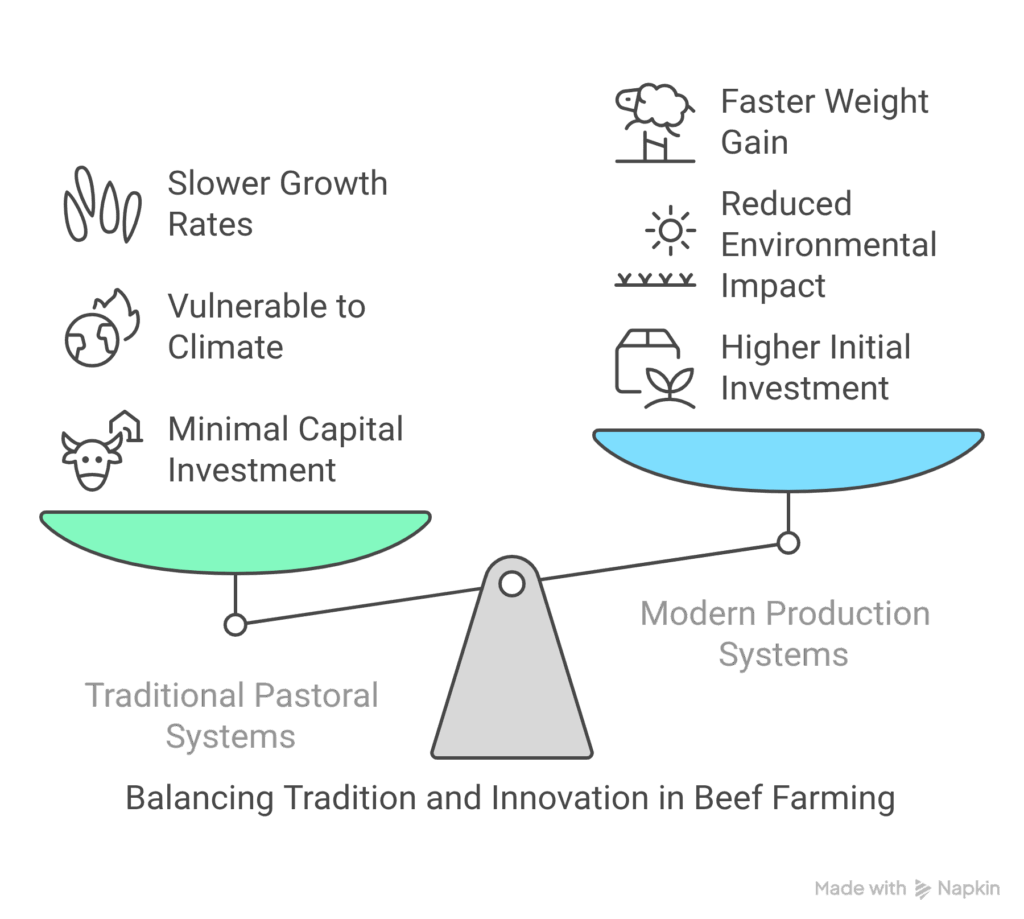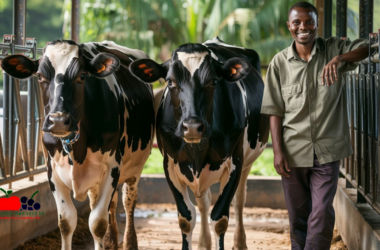Thinking about getting into the beef game in Kenya? Smart move. This isn’t just another farming venture—it’s tapping into what makes up over a third of Kenya’s agricultural GDP. With beef being the go-to protein for 80% of Kenyans, you’re looking at a market that’s hungry for quality product and primed for innovation.
Let me break down why beef farming in Kenya deserves your attention, whether you’re a first-time farmer looking to break into the industry or someone with a bit of land ready for a profitable pivot.
The Current State of Beef Farming in Kenya
Let’s get real about where Kenya’s beef industry stands right now. The sector contributes roughly 10% to Kenya’s overall GDP, with livestock being a cornerstone of the agricultural economy. The country currently hosts around 23.5 million cattle, though numbers vary depending on who’s counting—some sources report closer to 15.8 million.
Here’s what makes this interesting: despite being a major economic player, the beef sector in Kenya is still largely operating in traditional systems. About 90% of beef cattle are owned by subsistence farmers and pastoralists. These aren’t your modern commercial operations but communities that have raised cattle for generations—where cows aren’t just meat and money but also social currency.
The geographical spread tells its own story. Most commercial beef operations are set up in the Rift Valley Province—places like Nakuru, Trans Nzoia, and Kajiado Districts. The Coast Province, particularly Kilifi and Kwale, is where you’ll find larger ranching operations. These areas weren’t chosen at random—they’ve got the right mix of rainfall and ecology that beef cattle need to thrive.
The Demand Side
Here’s where it gets juicy: approximately 80% of Kenyans prefer beef as their meat of choice. That’s not a small market—that’s a massive opportunity. Even better? Local production isn’t meeting domestic demand yet. Recent data shows beef production is trending up, with the Kenya National Bureau of Statistics reporting that 2.78 million cattle were slaughtered in a recent year—a 7.3% jump from 2.59 million the year before.
When demand outstrips supply, that’s your cue to enter the market.
Traditional vs. Modern Production Systems
The beef farming landscape in Kenya is fascinating—it’s where ancient traditions meet modern innovation. Let’s break down how these different approaches stack up.
Traditional Pastoral Systems
The backbone of Kenya’s beef production remains its traditional pastoral systems. These farmers and pastoralists, who make up about 90% of the country’s beef cattle owners, primarily operate in the arid and semi-arid lands (ASALs) where approximately 36% of Kenya’s population lives.
These systems aren’t just about raising animals for slaughter—they’re deeply interwoven with cultural identity. For many traditional communities, cattle represent wealth, status, and heritage. The animals graze on natural vegetation, moving with the seasons in search of pasture and water.
While this approach requires minimal capital investment, it comes with challenges:
- Vulnerability to drought and climate change
- Limited control over animal nutrition
- Slower growth rates and time to market
- Disease susceptibility in communal grazing areas
Modern Approaches Gaining Traction
The game is changing though. Progressive farmers are adopting new systems that blend tradition with technology, and the results are impressive.
Take the Oramat cooperative model—it’s a brilliant example of innovation in action. This cooperative works on two levels: directly buying steers from communities and fattening cattle on behalf of community members. In just four years, they turned over KSh 64 million. Their six-month fattening period adds significant value to the cattle, with 80% of this value gain returned to the original owners.
Then there’s the emergence of feedlot systems—intensive operations where cattle are confined and fed a specialized diet to maximize growth. These systems might require more upfront investment, but they deliver:
- Faster weight gain
- More consistent meat quality
- Better market timing
- Reduced vulnerability to environmental factors

Which System Makes Sense for You?
Your choice depends on your starting capital, location, and scale ambitions:
| System | Initial Investment | Time to Market | Risk Level | Potential Returns |
|---|---|---|---|---|
| Traditional Pastoral | Low | 3-4 years | High (climate dependent) | Moderate |
| Semi-Intensive | Medium | 2-3 years | Medium | Good |
| Feedlot | High | 6-12 months | Lower | High (but capital intensive) |
For new entrants with limited capital, a hybrid approach might make the most sense—starting with a small herd managed semi-intensively, then gradually scaling up and adding feedlot finishing capabilities as you build capital and expertise.
Breaking Down the Value Chain
Understanding the beef value chain in Kenya is crucial before you dive in. Each stage presents different investment opportunities and challenges.
Animal Rearing
This is where it all begins—breeding and raising cattle until they reach market weight. Currently dominated by small-scale farmers and pastoralists, this stage is ripe for innovation.
Investment opportunity: Establishing breeding operations with improved genetics can create value by supplying quality animals to other farmers. Focus on breeds that combine local resilience with improved growth characteristics.
Animal Markets
Livestock markets typically operate weekly across different locations. Most lack basic infrastructure like weighing systems, meaning prices are often determined by visual assessment rather than objective measurements.
Investment opportunity: Market facilities with modern infrastructure represent an untapped business model. Providing weighing services, auction facilities, and transparent pricing mechanisms could transform how cattle are traded while generating revenue through service fees.
Slaughtering and Processing
Here’s a major bottleneck in the chain. Many areas lack modern abattoirs, though infrastructure improvements are happening. In Samburu Central, for example, a new abattoir is under construction. Before beef can be sold, it must be inspected by a Veterinary Extension Officer who declares it fit for human consumption.
Investment opportunity: Small to medium-scale slaughtering facilities with cold storage can command premium prices by ensuring meat safety and quality. Adding value through basic processing (cutting, packaging) further increases margins.
Marketing and Distribution
Most beef produced in Kenya stays in local markets. Limited access to regional or international export opportunities stems from inadequate processing and packaging facilities that would enable producers to meet standards for broader market access.
Investment opportunity: Creating brands that emphasize quality, traceability, and ethical production can command premium prices in urban markets. Developing export-ready processing to tap markets like Mauritius and the Middle East represents a higher investment but potentially lucrative opportunity.

The Challenges You’ll Face
Let’s not sugarcoat it—beef farming in Kenya comes with its share of hurdles. Being prepared for these challenges is half the battle.
High Feed Costs
One of the biggest obstacles, especially if you’re going the intensive production route. Feedlot systems require substantial capital investment and ongoing feed expenses that can eat into your profit margins.
Smart strategy: Invest in your own forage production where possible. Develop partnerships with crop farmers to utilize agricultural by-products. Consider vertical integration by producing your own feed.
Infrastructure Gaps
Many livestock markets lack basic facilities like weighing systems. There’s also a shortage of modern abattoirs and cold storage facilities throughout the country.
Smart strategy: Start where infrastructure exists or partner with others to share costs of essential infrastructure development. In some regions, county governments are investing in these facilities—research local development plans before choosing your location.
Disease Management
Common diseases like foot and mouth can devastate herds and severely impact production. Limited access to veterinary services, particularly in remote areas, compounds this challenge.
Smart strategy: Budget for comprehensive vaccination programs and regular veterinary visits. Consider employing a part-time or consulting veterinarian if your scale justifies it. Building quarantine facilities for new animals entering your farm is a worthwhile investment.
Climate Variability
With predominantly pasture-based systems, drought and climate change pose increasing threats to feed availability and animal health.
Smart strategy: Develop water harvesting systems and drought-resistant pasture options. Maintain flexible stocking rates and consider emergency feed reserves for dry periods.

Why Now Is the Time to Invest
Despite the challenges, the outlook for Kenya’s beef sector is bullish. Here’s why:
Population and Demand Growth
Kenya’s population is projected to nearly double to 96 million by 2050, with about half living in urban areas. This demographic shift, coupled with rising incomes, will drive greater demand for quality protein sources like beef.
The Food and Agriculture Organization (FAO) projects that by 2050, Kenya’s cattle population will increase by 90%, while beef production will rise to approximately 2,000 tonnes. That’s massive growth potential for those positioning themselves in the industry now.
Export Potential
With the successful creation of disease-free zones in coastal areas, Laikipia, and the North Rift, Kenya has already begun exporting livestock to markets such as Mauritius. As more processing facilities develop and international standards are met, export opportunities will expand, creating higher-value markets for producers.
Innovative Models Proving Successful
The Oramat cooperative shows how integrating modern technologies with traditional practices creates profitable and sustainable beef farming enterprises. Their use of microchip tagging for animal identification, systematic weight measurement, and transparent payment systems demonstrates practical approaches to addressing common industry challenges.
Best Practices for Success
Ready to jump in? Here are some proven approaches to maximize your chances of success:
Smart Breed Selection
Choosing the right cattle is fundamental. Popular local breeds like Boran and Sahiwal have naturally adapted to thrive in Kenya’s arid and semi-arid conditions. They show superior resilience to harsh environments, disease resistance, and ability to utilize low-quality forage.
Strategic crossbreeding with exotic beef breeds such as Hereford, Charolais, Simmental, and Angus can produce animals that combine local adaptation with faster growth and higher meat yields. These crossbred cattle often show hybrid vigor, resulting in improved productivity when managed well.
Feeding Strategies That Work
Beef cattle need balanced nutrition with adequate protein, energy, minerals, and vitamins. While natural pastures form the base of most feeding systems in Kenya, consider strategic supplementation with protein-rich feeds like lucerne (alfalfa) and commercial concentrates, particularly during finishing phases.
Ensuring consistent access to clean drinking water is equally important—water restriction severely limits feed intake and weight gain. Your feeding management must balance nutritional requirements with costs to maintain profitability.
Health Management Systems
Implement robust health practices from day one. Timely vaccination against common diseases like foot and mouth disease is essential. Establish a regular vaccination schedule based on specific disease risks in your area.
Regular deworming and appropriate external parasite control (dipping or spraying) further contribute to herd health and productivity. Maintain detailed health records for each animal to track interventions and identify patterns that might require management changes.
Getting Started: Your Action Plan
Ready to make your move into Kenya’s beef sector? Here’s a step-by-step approach:
- Research and Planning (3-6 months)
- Visit successful beef operations in your target region
- Connect with agricultural extension officers
- Develop a detailed business plan with realistic projections
- Identify your target market segment
- Land and Infrastructure (2-4 months)
- Secure appropriate land (owned or leased)
- Develop basic infrastructure (fencing, water sources, handling facilities)
- Plan for feed storage and animal housing needs
- Animal Acquisition (1-2 months)
- Source quality foundation stock from reputable breeders
- Consider starting small and scaling gradually
- Implement identification and record-keeping systems from day one
- Operations Launch
- Establish relationships with veterinary service providers
- Connect with potential buyers before your first animals reach market weight
- Join farmer associations for knowledge sharing and collective bargaining
- Scaling and Optimization (Ongoing)
- Reinvest profits into infrastructure improvements
- Gradually upgrade genetics through selective breeding
- Explore value addition opportunities as you grow

Future-Proofing Your Beef Business
The most successful beef farmers in Kenya aren’t just reacting to current conditions—they’re positioning for the future. Here’s how you can stay ahead:
Embrace Technology
From microchip identification systems to mobile apps for health monitoring, technology adoption can give you a competitive edge. Even simple tech solutions like WhatsApp groups connecting farmers directly with buyers are transforming how business happens.
Build Sustainability Into Your Model
Climate-smart farming practices aren’t just good for the planet—they’re good business. Rotational grazing, water harvesting, and drought-resistant forage production can reduce your vulnerability to climate shocks while improving your land’s productivity over time.
Consider Vertical Integration
As you grow, explore opportunities to control more of the value chain. This might mean investing in your own feed production, developing processing capabilities, or creating your own branded retail products. Each step toward vertical integration can improve margins and reduce vulnerability to market fluctuations.
Conclusion
Beef farming in Kenya sits at an exciting crossroads of tradition and innovation. The industry’s current contribution to the agricultural economy shows its importance, while projections of population growth and increasing demand point to a bright future.
Success in this space won’t come without challenges—infrastructure gaps, disease management, and climate variability will test your resolve. But for those who approach beef farming with the right combination of research, planning, and adaptive management, the opportunities are substantial.
Whether you’re drawn to the sector by its investment potential, passion for livestock, or desire to contribute to Kenya’s food security, now is the time to make your move. The country’s beef industry is primed for growth, innovation, and transformation—and it needs forward-thinking farmers like you to lead the way.
Ready to turn this opportunity into action? The first step is deepening your knowledge through government agricultural extension services, connecting with existing farmers, and visiting operations that align with your vision. Your beef farming journey begins now.
FAQs About Beef Farming in Kenya
How much capital do I need to start a small beef farming operation in Kenya?
Starting capital varies widely depending on your approach. For a small-scale operation (10-20 animals) using semi-intensive methods, budget approximately KSh 500,000-1,000,000. This includes basic infrastructure, initial stock purchase, and operating costs for the first few months. Going the traditional pastoral route requires less initial investment (around KSh 300,000-500,000) but comes with higher risks and longer time to market. Feedlot operations start at around KSh 2-3 million for a viable small commercial unit.
What breeds perform best in Kenyan conditions?
For most regions, adaptive local breeds like Boran and Sahiwal deliver the best balance of hardiness and productivity. In higher rainfall areas with abundant feed, crossbreeds with exotic beef breeds (Hereford, Charolais, Angus) can boost growth rates and meat yields. Your specific location should dictate your breed choice—what works in Laikipia might fail in Turkana.
How long does it take to realize returns on investment?
With traditional systems, expect 3-4 years before seeing meaningful returns. Semi-intensive systems can generate returns in 2-3 years. Feedlot operations can turn around capital in as little as 6-12 months, though with higher operational costs. Most successful farmers reinvest profits for the first several cycles to build scale before taking substantial personal income from the business.
What’s the most common mistake new beef farmers make in Kenya?
Underestimating feed costs and overestimating growth rates. Many business plans fall apart because they don’t account for seasonal feed scarcity or the true cost of supplementary feeding during dry periods. Close behind is inadequate disease prevention—skimping on vaccinations and parasite control to save money upfront leads to devastating losses later.
Can small-scale farmers compete with large ranches?
Absolutely—through specialization and quality focus. While you can’t match the volume of large operations, you can target premium market segments by producing higher-quality beef through careful breeding and management. Many small farmers also succeed by focusing on specific stages of production, like breeding quality calves for other farmers to fatten, rather than trying to cover the entire value chain themselves.
Is organic beef farming viable in Kenya?
There’s growing demand for organic beef, particularly in upscale urban markets and export sectors. The premium prices can offset lower productivity, but certification processes can be challenging and costly. Many traditional pastoral systems are essentially organic by default (minimal chemical inputs), but lack the certification to claim premium prices. This represents an opportunity gap for entrepreneurs who can navigate the certification process.
How does climate change affect beef farming in Kenya?
Climate change intensifies existing challenges—especially drought frequency and severity. Smart farmers are adapting by:
- Investing in water harvesting and storage
- Planting drought-resistant fodder varieties
- Maintaining flexible stocking rates
- Diversifying income streams within their farming operation
- Using mobile apps to access weather forecasts and early warning systems
What government support exists for beef farmers?
The government provides extension services through county agricultural offices, subsidized AI services in some regions, and occasional livestock off-take programs during severe droughts. Various initiatives support disease control, including vaccination campaigns against major diseases like foot and mouth. Additionally, projects like Kenya Climate Smart Agriculture Project (KCSAP) offer grants and technical support for climate-resilient livestock practices.










